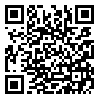Volume 18, Issue 112 (2021)
FSCT 2021, 18(112): 323-334 |
Back to browse issues page
Download citation:
BibTeX | RIS | EndNote | Medlars | ProCite | Reference Manager | RefWorks
Send citation to:



BibTeX | RIS | EndNote | Medlars | ProCite | Reference Manager | RefWorks
Send citation to:
rezaei M, Aran M, Amani A M, Miri M A, Ramezan D. Use of Electrospun Chitosan Nanofibers as Nanocarriers of Artemisia sieberi Extract: Evaluation of Properties and Antimicrobial effects. FSCT 2021; 18 (112) :323-334
URL: http://fsct.modares.ac.ir/article-7-46470-en.html
URL: http://fsct.modares.ac.ir/article-7-46470-en.html
1- Department of Horticulture, Faculty of Agriculture, University of Zabol
2- Assistant Professor, Department of Horticulture, Faculty of Agriculture, University of Zabol ,mehdiaran@uoz.ac.ir
3- Department of Medical Nanotechnology, School of Advanced Technologies in Medicine, Shiraz
4- Department of Food Industry, Faculty of Agriculture, University of Zabol
5- Department of Horticultural Science, College of Agriculture, University of Zabol,
2- Assistant Professor, Department of Horticulture, Faculty of Agriculture, University of Zabol ,
3- Department of Medical Nanotechnology, School of Advanced Technologies in Medicine, Shiraz
4- Department of Food Industry, Faculty of Agriculture, University of Zabol
5- Department of Horticultural Science, College of Agriculture, University of Zabol,
Abstract: (3152 Views)
Artemisia is an important medicinal plant which is widely used in the treatment of skin diseases and it has antimicrobial properties. This research was carried out with the aim of making nano-fibers with Artemisia sieberi Besser extract to study its antimicrobial properties against Pseudomonas aeruginosa and Staphylococcus aureus bacteria. Artemisia extract and electrospinning solution containing 0.2 g of polyethylene oxide, 0.05 g of chitosan and 1.5 ml of acetic acid were prepared and then nanofibers were produced by electrospinning of the solutions. Artemisia Extract loading with 100 mg/ml extract had a significant effect on the diameter of fibers and the average fber diameter with Artemisia extract (218.4 nm) compared to the fibers without extract (204.8 nm) were higher. The tensile stress at the tear point of the nanofibers with Artemisia extract (3.04 MPa) was lower than the fibers without the extract (3.46 MPa) and elongation at break was higher (7.6%).The nanofibers with the extract had more resistance temperature than non-extract fibers. This is due to the crystal state of Artemisia extract in the fibers. The nanofibers produced with Artemisia extract had inhibitory properties for both studied bacteria. Nanofibers with 100 mg/ml extract completely controlled the bacterial growth. Nanofibers with 20 and 50 mg/ml of extract had a better inhibitory effect on Pseudomonas aeruginosa than Staphylococcus aureus. The Addition of Artemisia extract improved the antimicrobial properties of chitosan nanofibers.
Article Type: Original Research |
Subject:
Nanotechnology in the food industry (nanoparticles, nanocapsulations, nanomolies, etc.)
Received: 2020/09/30 | Accepted: 2020/12/5 | Published: 2021/06/6
Received: 2020/09/30 | Accepted: 2020/12/5 | Published: 2021/06/6
Send email to the article author
| Rights and permissions | |
 |
This work is licensed under a Creative Commons Attribution-NonCommercial 4.0 International License. |







